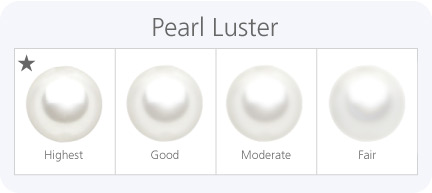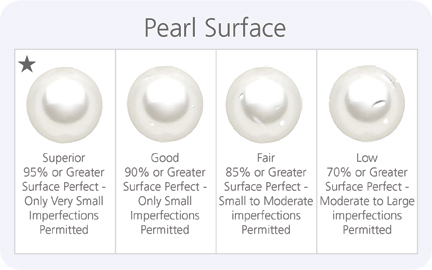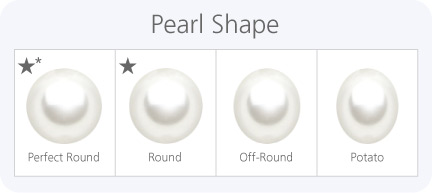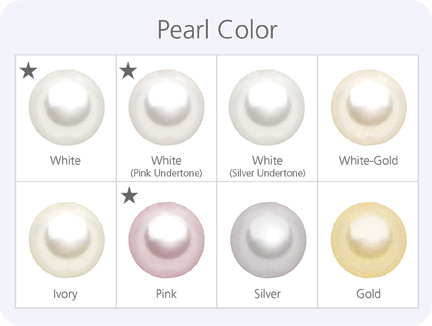Pearl Quality Education
Pearl Quality Compared
Pearls are a beautiful exquisite treasure. One of the most popular forms of jewelry or gemstone on the planet. Beloved since the beginning of time, this treasure of the sea has been used to show a person's power, wealth, and refinement, and being adorned on only the most wealthy members of nations. Find out below the value of different pearl grades, learn to descern shapes, and be knowledgible about the most important factors of a pearls value.
First, we would like to show you a comparison of what good quality pearls look like (like the ones we use here at Tiny Blessings), and poor quality or craft quality pearls used by other companies for their children's jewelry.

Grading Factors
Aside from the size of a pearl, there are five main factors in defining the quality of a given pearl, they are; luster, surface, shape, nacre, and color. Each has its importance in creating the perfect pearl. Since not all pearls can be perfect pearls, they have to be graded using jewelry industry standards and by a trained jewelry professional who has seen tens of thousands of pearls, and so has the experience and expertise to easily rate pearls on this criteria.
Luster
Luster is most similar to the word "shine" and is an indicator of how well the pearl reflects light and shadow. A good way to think of luster is like a mirror, the foggier the mirror, the less sharp it reflects. This quality is one of the highest and most important indicators of good pearls.

 This is the only grade used by Tiny Blessings
This is the only grade used by Tiny BlessingsSurface
This indicates how smooth and unflawed the surface of the pearl is graded to be. Small natural imperfections like scratches, bumps, marring, and crater like divots cause a pearl to have a lower surface quality. Highest quality pearls are rated to have 95% or higher surface area perfection.

 This is the only grade used by Tiny Blessings
This is the only grade used by Tiny BlessingsShape
Since pearls grow naturally, the can grow in many shapes and have to be categorized into groups. The best know pearl shape groups are the following; Perfect Round, Round, Off-Round, Potato, Baroque, Button, and Drop shaped pearls. The "Perfect Round" category is the ideal pearl with less round pearls being less desirable based on how far from perfect round they tend to be. Although, pearl shapes that have character and unique look, like baroque, are more desirable them some "Off-Round" or "Round" categorized pearls. This may be the biggest factor, next to size, in determining the value of pearls.

 These are the only grades used by Tiny Blessings
These are the only grades used by Tiny Blessings * This grade is available for an additional charge if desired
* This grade is available for an additional charge if desiredNacre
Nacre and luster are closely tied in the rating value of a pearl. The thicker the nacre the more shiny or lustrous the pearl appears. Thicker nacre makes for a more robust pearl and creates an illusion of depth. Since it is linked with luster, one of the most desirable qualities, nacre is a valuable quality in a pearl. (See table above showing pearl images in luster grades)
Color
Some colors are simply more preferred, like white and pink are two colors that are more popular than gold or ivory. These color preferences may change with trends, and thus the price differences between colors may alternate, but white is, and always will be the most popular color choice.

 These are the only colors used by Tiny Blessings.
These are the only colors used by Tiny Blessings.Note: We accept both white and white with pink undertone from our pearl farms, both are equally as valuable and beautiful. We do not mix white and white with pink undertone pearls, you either get one or the other.
Other Grading Factors
- Some professionals also look at pearl weight. The value of weight equaling the heavier the pearl, for its size, the more valuable.
- Some jewelers use a 4A (AAAA to A) grading system or a 5A (AAAAA to A) grading system. Do NOT be fooled by this marketing trick, they are just marketing AAA grade pearls as AAAA or AAAAA grade to mislead people into thinking they have better quality pearls than everyone else. You should beware of purchasing pearls from these jewelers, if they are interested in misleading you on the quality, it is no stretch of the imagination to think that they would mislead you on the other aspects of their jewelry.
Freshwater Pearl Grading Chart
(unique shapes not evaluated)
Grades used by Tiny Blessings are indicated by a blue background
| Professionally Graded as... | Professional Shape Designation | Price | TinyBlessings.com Grade Name | Description |
|---|---|---|---|---|
| Grade AAA Loose | Perfect Round |
$$$$$$$$$$ |
Grade AAA Perfect Round |
Highest Luster Used in the finest jewelry, found in the finest jewelry collections, mainly single pearls set in pendants or necklaces to showcase the pearl's beauty. Note: Less than 2% of all pearls collected by the farm will meet this high quality standard. |
| Grade AAA Strands | Round | $$$$$$$$$ | Grade AAA Round |
Highest Luster Used by high-end jewelers for exquisite pearl necklaces and bracelets that command a high price. |
| Grade AAA Strands | Off-Round | $$ $$ |
N/A (Not Used in Jewelry made by TinyBlessings.com) |
Highest Luster Used by jewelers for beautiful pearl necklaces and bracelets that are a little more affordable and have a mid-range price. |
| Grade AAA Strands | Potato | $$ |
N/A (Not Used in Jewelry made by TinyBlessings.com) |
Highest Luster Used by some jewelers for mid-low quality necklaces and bracelets with an unbeatable price point. Also used prominently in high-quality craft beading and jewelry for boutiques. |
| Grade AA Loose | Perfect Round to Round | $$$$$$$ |
N/A (Not Used in Jewelry made by TinyBlessings.com) |
Good Luster; Less than 15% Inclusions on Surface; Medium Nacre; Near Round; Excellent Matching. Used by jewelers in mid-quality rings, pendants, and earrings. |
| Grade AA Strands | Off-Round | $$$ |
N/A (Not Used in Jewelry made by TinyBlessings.com) |
Moderate Luster; Less than 30% Inclusions on Surface; Medium to Thin Nacre; Off-Round; Good Matching Used primarily for mid-quality craft jewelry and some dress ornamentation. |
| Grade A Strands | Potato | $ |
N/A (Not Used in Jewelry made by TinyBlessings.com) |
Moderate to Low Luster; Less than 30% Inclusions on Surface; Thin Nacre; Potato Shape; Moderate Matching This low quality pearl is used in home craft projects, and the very cheapest jewelry, where pearls are never the focus and add very little value. |
Cultured Pearls vs. Naturally Occuring Pearls
Cultured pearls are real pearls are both created by real oysters, in fresh or salt water, that are farmed for commercial production of high-quality pearls. Much like farmed salmon or trout, these are exactly the same fish, just raised in an area they can be harvested with little trouble. Naturally occuring pearls are extremely rare and since pearl oysters are no longer commercially fished to find pearls, these beautiful accidents of nature are rarely found in any type of jewelry, but when they are, they are sold at a huge premium. Talk about a premium, in 2007 a rare strand of 68 perfect natural pearls, known as the 'Boroda Pearls', was auctioned for over $7 million to an undisclosed buyer. Yes, that is over $100,000 per pearl.
Facts about Cultured Pearls
- Over 99.99% of all real pearls used in the jewelry industry today are cultured pearls
- Of all the pearls collected in commercial pearl culture farm, only 60 % of the pearls have any value at all, the remaining 40 % are worthless and are generally trash.1
- Vinegar is acidic and can cause natural and cultured pearls to dissolve if left in vinegar.2
